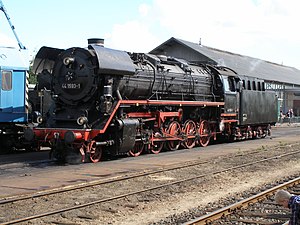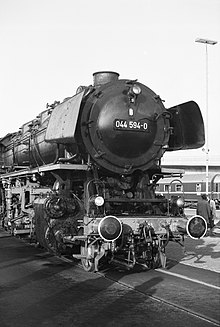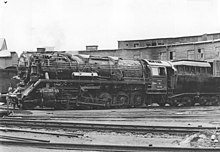DR series 44
| DR series 44 PKP Ty4 SNCF 150 X TCDD 56.701-748 |
|
|---|---|
|
44 1593-1 of the Veluwsche Stoomtrein Maatschappij (Netherlands)
|
|
| Number: | 1989 |
| Year of construction (s): | 1926-1949 |
| Type : | 1'E-h3 |
| Genre : | G 56.20 |
| Gauge : | 1435 mm ( standard gauge ) |
| Length over buffers: | 22,620 mm |
| Height: | 4550 mm |
| Width: | 3105 mm |
| Fixed wheelbase: | 3400 mm |
| Total wheelbase: | 9650 mm |
| Service mass: | 110.2 t |
| Friction mass: | 95.9 t |
| Wheel set mass : | 19.3 t 20.1 t (44 001-010) |
| Top speed: | 80 km / h / 70 km / h (forwards) 50 km / h (backwards) |
| Indexed performance : | 1405 kW / 1910 PSi coal 1545 kW / 2100 PSi oil |
| Starting tractive effort: | ~ 269 kN ~ 280 kN (44 001-010) |
| Driving wheel diameter: | 1400 mm |
| Impeller diameter front: | 850 mm |
| Number of cylinders: | 3 |
| Cylinder diameter: | 550 mm 600 mm (44 001-010) |
| Piston stroke: | 660 mm |
| Boiler overpressure: | 16 bar 14 bar (44 001-010) |
| Number of heating pipes: | 128 127 (44 001-010) |
| Number of smoke tubes: | 43 |
| Heating pipe length: | 5800 mm |
| Grate area: | 4.55 m² 4.73 m² (44 001-065) |
| Radiant heating surface: | 18.30 m ² 18.33 m² (44 001-065 without 011/012) |
| Tubular heating surface: | 219.67 m² 218.77 m² (44 001-010) |
| Superheater area : | 100.00 m² |
| Evaporation heating surface: | 237.67 m² 237.10 m² (44 001-010) 238.00 m² (44 013-065) |
| Tender: | 2'2 'T 32/34, a few also with tub tender |
| Water supply: | 32.0 m³ / 34.0 m³ |
| Fuel supply: | 10.0 t coal or 12 m³ oil (conversion 2'2 'T 34) |
| Brake: | self-acting single-chamber compressed air brake type Knorr |
| Control: | Heusinger |
| Particularities: | 44 004, 44 009 (temporarily more) with Riggenbach counter pressure brake |
The locomotives of the series 44 of the German National Railroad were heavy, ten-coupled freight train - einheitsdampflokomotive the genus G 56.20 with triple engine. They were intended for the transport of freight trains up to 1,200 tons on low mountain ranges and 600 tons over steep ramps.
history
The first ten copies were built in 1926. These machines had a slightly higher steam consumption than the first ten copies of the series 43 equipped with a twin engine, which were procured in parallel for comparison purposes . It was not until 1937 that more copies were procured, because the requirements for train conveyance, which had increased in the meantime, could be better managed with the triple engine. A total of 1,989 locomotives were manufactured between 1926 and 1949.
During the Second World War , the war-related simplification of the design took place from 1942 and the units built in this way were delivered as class 44ÜK ( transitional war locomotive ). Mainly home fabrics were used, components were simplified in production and design or omitted entirely. The most noticeable features of the ÜK locomotives were the omission of smoke deflectors (which were standard from 44 013) and the omission of the front driver's cab side window. Starting with road number 44 786, all machines were probably made in a simplified version. For the locomotives that remained in service after the end of the war, the simplifications were largely eliminated later.
After the Second World War, the class 44 locomotives built for the DR in 1753 remained with the following railway administrations:
- 1,242 units: Deutsche Bundesbahn (DB, from September 1949)
- 335 pieces: Deutsche Reichsbahn (DR)
- 67 pieces: Polskie Koleje Państwowe (PKP)
- 3 pieces: Československé státní dráhy (ČSD)
- 11 pieces: Austrian Federal Railways (ÖBB)
- another 5 pieces: ÖBB (T), booty from the Soviet occupying power
- 14 pieces: Société nationale des chemins de fer français (SNCF) (referred to as the 150 X series)
- 1 piece: National Company of Belgian Railways (SNCB)
- 74 pieces: whereabouts unknown
Since the production of the 44 series was concentrated in French plants at the end of the war, a further 226 locomotives were delivered directly to the SNCF after the German occupiers had withdrawn. Another ten copies were completed in 1948/49 using Frichs boilers in Aarhus at the Lokomotivbau Elektrotechnische Werke Hans Beimler Hennigsdorf for the DR.
The Austrian Federal Railways (ÖBB) handed over nine machines to the German Federal Railroad (DB) in 1952 . The DB transferred at least 291 machines to the French State Railways (SNCF) as reparations. These were mainly locomotives built in France. In 1955, the SNCF again sold 48 machines to the Turkish state railway TCDD (there as class 56).
In Poland , Polskie Koleje Państwowe (PKP) added 132 machines as Ty4 to their inventory.
More extensive modifications were made to the sixties with the Federal Railroad on the machines can be seen from replacement of Wagner - skirting by such type of Witte from. In 1964 and 1965 over sixty machines were converted to oil firing. The retirement began in 1970 and was completed in 1977.
Until they were replaced by modern diesel and electric locomotives , the 44 series machines were the backbone of heavy freight train service in Germany.
The German railway workers also called the 44 series because of its tractive power "Jumbo". Only the class 58.30 locomotives reconstructed by the Deutsche Reichsbahn between 1958 and 1962 reached the level of performance of the class 44 in the lowlands. The few machines in the 45 series had a higher top speed and performance, but did not have a higher tractive power.
construction

The maximum speed of the series version is 80 km / h, the pre-series (44 001 to 44 010) was only approved for 70 km / h. It is outer than three-cylinder engine with two and one lying in the center of the vehicle below the boiler cylinder executed. The 44 series only has simple steam expansion, i.e. no compound drive. The outer cylinders work on the third, the inner one on the second coupled gear set, which is equipped with a cranked axle shaft.
The standard 2'2 'T 32 and 2'2' T 34 tenders were mainly used. Short tenders of the type 2'2 T 30 (especially pre-series locomotives) or test tub tenders of the type 2'2 'T 34 were rare . At the DR there was a shortage of modern standard tenders until the end of the 1960s, because the Rekoloks of the 22 and 58.30 series were also to be equipped with them, which is why many of the 44 series locomotives with Prussian 2'2 'T 32 tenders (originated from pr 2 '2' T 31.5 ) ran. When the class 44 locomotives were put into service, many new 2'2 'T 34s were immediately exchanged for older standard tenders, as the large tenders were needed more urgently for express locomotives. All types hold ten tons of coal.
Oil- fired locomotives ran exclusively with tenders 2'2 'T 34 . At the DB the oil tank held 11.2 cubic meters, at the DR, with 13.5 cubic meters, a little more fuel could usually be carried.
The coal dust tenders for the 44 series were mainly the result of the conversion of the type 2'2 'T 30 tub tenders and the large standard type 2'2' T 34 tenders , rarely also from the riveted 2'2 'T 32 tenders . At first a coal dust chamber was installed, but there were some problems with the complete discharge of the fuel. Therefore only three-chamber tenders were built later. Although they had a slightly smaller water supply, the coal dust they carried could be reliably and completely burned. The most common types were the tub tender 2'2 'T 24 Kst with 21 m³ coal dust and the welded 2'2' T 28 Kst with 23 m³ or ten tons of coal dust.
Executions
The 44 series consumed a lot of steam and accordingly a lot of coal. In order to simplify the work and to keep the output constant, 36 locomotives were converted from 1958 at the DB and from 1963 at the Deutsche Reichsbahn 97 locomotives to main oil firing. In the case of the main oil firing , the viscous heavy oil , which is almost solid when cold, is preheated in the tender to around 70 ° C so that it can flow, atomized by a jet of steam in the combustion chamber and then burned.
The DB's oil-fired locomotives had the series designation 043 in the new EDP-compatible numbering scheme from 1968 until they were retired . This series number was free at the DB because all vehicles of the original DR series 43 were now part of the DR fleet. The grate-fired machines were given the series designation 044 .
The Deutsche Reichsbahn converted 22 locomotives to the Wendler coal dust firing system . This has proven itself especially on the ramps of the Thuringian Forest through precise firing. A conversion of further locomotives was not carried out - among other things because investments in further expensive stationary systems for supplying coal dust to the locomotives were shied away from - in favor of a main oil firing system, which enabled more permissive circulation. At the DR, too, a distinction was made in the EDP numbers introduced in 1970 according to the type of combustion: oil locomotives were given the numbers 44 0 , coal locomotives 44 1 and 44 2 and coal dust locomotives 44 9 .
At DB, coal-fired and oil-fired locomotives could keep in operation for almost the same time. The last coal-fired locomotive class 44 was in May 1977 Bw Gelsenkirchen-Bismarck retired. As the last service, 043 903-4 carried the train 81453 (consisting of an auxiliary train equipment wagon) from Oldersum to Emden Rbf on October 26, 1977 for the Neubauamt Nord, it was also the last train service of the Deutsche Bundesbahn to be transported by steam locomotive.
At the DR, the coal locomotives, due to the electrification of their main routes in Thuringia and Saxony and the replacement by large diesel locomotives of the V 200 series and later the 130 series, hardly played a role in operational service when the EDP numbers were introduced in 1970. The last one to be parked was Altenburger 44 2082-4 (44 082) in August 1974. From November 1974 onwards, the last pulverized coal locomotive of this series was no longer in operation.
It was originally planned to complete the traction changeover with the 44-Oil, as with the DB, but since 1979 the heavy bunker oil could be further split, so it was no longer waste. When the Soviet Union then significantly increased the price of crude oil again in the wake of the second oil crisis in 1981 and above all reduced the delivery quantities (in the meantime they had noticed that the GDR was selling petroleum products to improve the foreign exchange balance in the West), it also had an impact on the operation of the Series 44. In January 1982, oil-fired operation was completely discontinued and most of the machines were reduced to grate-firing. The first converted machines left the RAW fully refurbished, but were no longer used in regular train service. Later they were only converted into heating locomotives or stationary heating systems . The BKK Geiseltal acquired copies 44 851 and 44 1278 for its factory railway in 1982 and had them converted to coal dust firing according to plans from the Meiningen repair shop . However, their use only lasted a few years because the locomotives were not properly maintained.
Whereabouts

There are currently two operational "44s" around the world: 44 1486 is kept in the traditional Staßfurt depot. In the Netherlands, at Veluwsche Stoomtrein Maatschappij VSM in Beekbergen, 44 1593 is operational.
In some German railway museums, the following inoperable class 44 locomotives can be viewed:
- 044 389-5 (ex 44 389) as a monument locomotive in Altenbeken ,
- 44 404 in the Railway Museum Darmstadt-Kranichstein (see also test locomotive),
- 44 481 in the Technik-Museum Kassel in Kassel-Rothenditmold,
- 44 508 (owner: DB Museum ) in the former Westerburg (Westerwald) depot,
- 44 546 Bavarian Railway Museum in Nördlingen
- 44 594 Dampflokfreunde Salzwedel eV in Wittenberge,
- 043 903-4 (ex 44 903) as a monument locomotive on the station forecourt in Emden ,
- 44 1093 (owner: DB Museum ) in the Arnstadt depot ,
- 043 196-5 (ex 44 1203) as a monument locomotive at the train station in Salzbergen
- 44 1338 in the Saxon Railway Museum Chemnitz-Hilbersdorf, former heating locomotive ,
- 044 377 (ex 44 1377) in the Bochum Railway Museum ,
- 44 1558 in Gelsenkirchen-Bismarck ,
- 44 1681 (oil firing) in the Horb am Neckar railway adventure world .
Test locomotives
| Series 44 (medium pressure) | |
|---|---|
| Numbering: | 44 011-012 |
| Number: | 2 |
| Year of construction (s): | 1932-1933 |
| Genre : | 1'E-h4v |
| Gauge : | 1435 mm ( standard gauge ) |
| Length over buffers: | 22,675 mm |
| Empty mass: | 105.2 t |
| Service mass: | 114.9 t |
| Service mass with tender: | 188.5 t (with tender 2'2 'T 32 type 1926 and full stocks) |
| Friction mass: | 100.0 t |
| Wheel set mass : | 20.2 t |
| Top speed: | 80 km / h |
| Indexed performance : | 1,868 kW / 2540 PSi |
| Starting tractive effort: | ~ 227 kN |
| Driving wheel diameter: | 1,400 mm |
| Impeller diameter front: | 1,000 mm |
| Control type : | External Heusinger control for low pressure cylinders with pendulum shaft to move the inner slide |
| Number of cylinders: | 4th |
| HD cylinder diameter: | 440 mm |
| LP cylinder diameter: | 700 mm |
| Piston stroke: | 660 mm |
| Boiler overpressure: | 25 bar |
| Number of heating pipes: | 83 |
| Number of smoke tubes: | 46 |
| Grate area: | 4.73 m² |
| Radiant heating surface: | 17.40 m² |
| Tubular heating surface: | 203.04 m² |
| Superheater area : | 113.00 m² |
| Evaporation heating surface: | 220.44 m² |
| Tender: | 2'2 'T 32 type 1926 |
| Water supply: | 32 m³ |
| Fuel supply: | 10 tons of coal |
In 1932 and 1933, the Henschel company built two test locomotives with a boiler pressure increased to 25 bar and a four-cylinder compound engine , which were also classified in the 44 series. The two machines, which initially ran under the numbers M 01 1004 and M 01 1005 , later as 44 011 and 44 012, were very powerful, but also prone to repair. The initial overpressure in the boiler was quickly reduced from 25 bar to 16 bar.
After the Second World War, 44 011 came to the Deutsche Bundesbahn and 44 012 to the Deutsche Reichsbahn in the GDR . The DB machine was retired as a loner in 1950. The 44 012 was used by the FVA Halle as a brake locomotive and was not taken out of service until 1962.
The Braunschweig repair shop installed a Riggenbach counter-pressure brake in the 44 404 in 1975 . The Federal Railway Central Office in Minden used this locomotive as a brake locomotive for testing new electric locomotives. In 1977 this locomotive was retired. It is now in the Darmstadt-Kranichstein Railway Museum .
literature
- Heinrich Sell: Strong locomotives for heavy trains - the series 44 at the DR . Railway picture archive, EK-Verlag, Freiburg 2005, ISBN 978-3-88255-356-7
- Peter Konzelmann: The 44 series . EK-Verlag, Freiburg 1981, ISBN 3-88255-144-5
- Manfred Weisbrod: The 44 series . Hermann Merker Verlag, Fürstenfeldbruck 1994, ISBN 3-922404-55-3
- Manfred Weisbrod, Wolfram Brozeit: The BR 44 locomotives - their way through six decades . alba-Verlag, Düsseldorf 1983, ISBN 3-87094-122-7
Web links
- Railway friends Stassfurt
- eisenbahnfreunde-zollernbahn.de
- www.museumslok.de
- Westerwald adventure station, Westerburg - home of 44 508
- Veluwsche Stoomtrein Maatschappij, home of the 44-1085 and 44-1593
- Bahnwelt Darmstadt-Kranichstein, home of 44 404
- Information on the surviving class 44 locomotives on the "Railway Museum Vehicles" website
Individual evidence
- ↑ Thomas Estler: Locomotives of the Polish State Railways PKP . 1st edition. transpress, Stuttgart 2013, ISBN 978-3-613-71466-3 , pp. 25 . The sources contain different figures: Tomasz Galka (accessed on February 7, 2015) justifies and substantiates his figures in detail, which are in the range of Estler's. Here (accessed on February 7, 2015) is a collection of revision data that at least suggests that the number of only 67 machines is rather unlikely.
- ↑ Jan Reiners: Brief typology of German museum steam locomotives . Transpress-Verlag, Stuttgart 2002, ISBN 3-613-71187-7 , p. 35 f. (induced tensile force 0.8: BR 44: 27.38 Mp, BR 45: 23.36 Mp)
- ↑ Michael Dittrich: The ONLINE vehicle database on the Internet. In: revisionsdaten.de. Retrieved June 7, 2016 .









